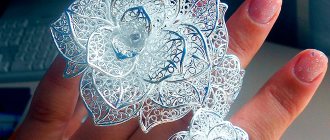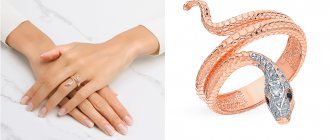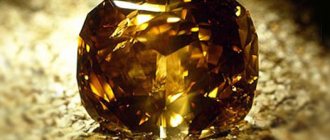BLOG OF THE HOUSE “LOBORTAS”
Part One - Garrard
The history of Asprey & Garrard, “Asprey and Garrard” is almost a three-hundred-year chronicle of two ancient English jewelry houses Garrard & Co and “Asprey”, which have a rich history and established traditions.
And despite the fact that their joint union lasted only four years, each of the jewelry Houses made their invaluable contribution to the world jewelry treasury. In the old days, as today, among royalty and nobility, talented jewelers were honored and respected and were worth their weight in gold. They were entrusted with the creation of crowns and royal regalia, weapons, tiaras, pendants and necklaces, wedding and engagement rings, buttons and cufflinks. There were queues of people who wanted to possess this shining splendor, because jewelry is an aura of power and might, greatness and status.
House of Garrard
A similar fate was destined for the talented master George Weeks (1698-1761). By the time Wicks was 24, he was already a member of the Goldsmiths' Guild, and had become famous as an accomplished silversmith for his work in the Rococo style. In 1722, despite his youth, George took the risk of starting his own business. This event heralded the beginning of a dizzying career for the jewelry house, which would later become known as Garrard&Co.
The official foundation of the Garrard & Co jewelry house dates back to the moment the Wicks workshop moved to the goldsmiths' district, in the center of London on Panton street in 1735. He is patronized by the Prince of Wales, Frederick. In the books of Garrard & Co there is an entry dating from 1735: "HRH Frederick, Prince of Wales".
Frederick Lewis Prince of Wales by Philip Mercier.
It is safe to say that throughout its history, the jewelery house of Garrard & Co has worked closely with the British royal family, starting with Frederick, Prince of Wales and each subsequent British monarch, creating many beautiful jewels.
Gradually, George Weeks's workshop is turning into a serious, dynamically developing and prosperous company, creating magnificent luxury jewelry.
Necklace pendant. Gold, diamonds, emeralds, enamel. Garrard&Co, 1870. Sotheby's New-York.
During its existence, Vicks' company was repeatedly passed from hand to hand, changing its owners. In 1760, George Wicks's company was acquired by his students John Parker and Edward Wakelin, and in 1776 they were replaced by John Wakelin and William Taylor. In 1792, after the death of William Taylor, Robert Garrard became a partner in the company. In 1802, Robert Garrard became the sole owner of the George Wicks company and transferred control to his sons Robert Garrard II, James and Sebastian. The brothers succeeded in management until James retired in 1835, changing the name to R & S Garrard.
In 1843, the most important event in the history of the Garrard jewelry house took place: the young Queen Victoria awarded the House the honorary title of court jeweler.
Queen Victoria.
The privileges granted opened up endless possibilities for Garrard & Co. From now on, the design of the official royal jewels and regalia, their production and maintenance, as well as the care of the monarch's collection of silver and jewelry became the responsibility of the House of Garrard. For 166 years, every winter for two weeks, Garrard & Co sent a team of its craftsmen to the Tower, and the jewelers, guarded by armed guards, carried out preventive maintenance and repairs to the royal jewels.
Royal treasures in the Tower.
In 1848, Garrard & Co created a cup called the America Cup. The America's Cup is one of the most famous and most prestigious regattas in the world. It is the world's oldest international competition in all sports, predating the FA Cup by two decades and predating the first modern Olympic Games by 45 years, and is the oldest international sports trophy.
America's Cup
In 1849, the Indian treasury of Lahore, which contained the famous Koh-i-noor diamond, came into the possession of the British authorities. On April 6, 1850, the Koh-i-noor left India and reached Britain on July 2, 1850, where it was handed over to Queen Victoria. In 1851, the diamond was exhibited at the Great Exhibition in London.
The Koh-i-noor diamond at the Great Exhibition in London in 1851.
Despite the fact that the precious stone had a bad reputation as an object that brought misfortune to the owner, the queen ignored prejudice and wore it in her crown. By that time, “Koh-i-noor” still retained the shape of the ancient Indian cut.
In this form, the Koh-i-nor diamond was given to Queen Victoria in 1851.
Prince Albert, along with jeweler Sebastian Garrard, said that the gem has a rose shape inappropriate for a diamond and that the new cut will make the Koh-i-noor sparkle anew. They decided to turn to experienced mineral cutters. To carry out the work, a small machine with a steam engine was made. After 38 days of painstaking work, which cost the English treasury a tidy sum, the diamond was practically free of yellowness and became lighter. Thus, the oval-shaped Koh-i-noor diamond weighing 108.93 carats was born. During the new cutting process, Koh-i-noor lost 43 percent of its weight.
Koh-i-noor diamond cut.
The expediency of this procedure caused a storm of criticism and doubts, since the diamond, with its original Indian cut in the shape of a rose, was of enormous cultural and historical value. In 1853, the magnificent Koh-i-noor diamond became an adornment of the royal tiara, which already included more than two thousand precious stones.
Oval shaped Koh-i-noor diamond in the British Royal Crown.
The jewelers of the Garrard&Co House demonstrated all their skill and skill when creating a small crown in 1871 for the participation of their patron, Queen Victoria, in official events. It is in it that the queen is depicted in most paintings and sculptures. The prerequisite for this event was the death of Prince Albert, and the queen’s health, which sharply deteriorated in connection with this event - she suffered from migraines and could not wear a “full-size” crown. Queen Victoria liked the crown so much that she did not part with it until her death.
Queen Victoria.
In November 1907, the world's largest diamond, the Cullinan Diamond, was presented to King Edward VII of Great Britain on his 66th birthday. The diamond had exceptional clarity and a white-bluish tint.
By order of King Edward VII in 1910, the Cullinan I Diamond was mounted by Garrard & Co into the top of the royal scepter, which is currently on display in the Tower of London. The rest of the Cullinan diamonds were, for the most part, used by jewelers Garrard & Co to create the famous Cambridge and Delhi Durbar Parure. The parure was created by Garrard & Co to commemorate the coronation of George V and Mary on June 22, 1911, and their subsequent conferment of the title Emperor and Empress of India at a special ceremony in Delhi on December 12 of the same year.
Royal scepter.
In 1911, Garrard & Co's workshop and store moved to 24 Albemarle street, where it remains to this day, maintaining an honorable status.
Jewelry House Garrard. 24 Albemarle St, Mayfair, London.
A manifestation of special trust in Garrard & Co was an order from the leadership of the British Armed Forces to create rangefinders for the accuracy of artillery fire. In 1915, the Garrard Engineering and Manufacturing Company division was created, which developed and produced the necessary equipment. In 1920, in its new engineering and production building, Garrard & Co successfully mastered the production of spring motors for a sound recording device - the gramophone. The gramophone motor developed by Garrard & Co engineers is the finest spring motor ever produced.
Player from Garrard&Co.
The name Garrard & Co is inextricably linked with coronation ceremonies, as well as with the high responsibility and prestige that accompanies the holder of the title of Royal Jeweler.
It was the jewelers Garrard & Co who prepared the “The Imperial State” crown for the coronation of George VI in 1937.
The Imperial State.
Garrard & Co remained in the hands of the Garrard family until the death of Sebastian Henry Garrard, great-grandson of Robert Garrard Snr, in 1946.
Over the many years of its glorious existence, Garrard & Co has changed its owners more than once, but the charm and elegance of the fantasy beauty of the jewelry has remained unchanged.
Bracelet with diamonds. Garrard&Co, 1950s. Sotheby's London.
The House of Garrard & Co did not ignore the members of the royal family who are closer to our time. The wedding of Princess Elizabeth in 1947, the redesign of the Crown of the British Empire for Queen Elizabeth II in 1952, Lady Diana's diamond tiara with teardrop pearls, the wedding rings of Diana and Prince Charles, the status of supplier to the royal court obliged...
Jewelers of the House of Gerrard
In 1998, it became necessary to merge the jewelry house Garrard & Co with another famous ancient jewelry company - Asprey.
Jewelry house "Garrard"
Recognized for its classic, timeless designs, Garrard jewelry is at the heart of many dynastic family jewelry collections. The company's jewelry is luxurious works of art. Each item is carefully and thoughtfully selected to order and is a reflection of the aesthetics and quality of classic Britain. Garrard created the sapphire engagement ring given by the Prince of Wales, Duke of Cambridge, to his future wife Catherine. The ring once belonged to Lady Diana, Princess of Wales.
Garrard & Co. Limited (Asprey & Garrard Limited) is engaged in the manufacture of luxury jewelry.
The company was founded in 1735 in London by George Wickes (1698–1761). Garrard's headquarters are located on Albemarle Street in London. Garrard also has representative offices in Harrods, London, Geneva, Lebanon, Qatar Dubai, Moscow and Hong Kong. Garrard was a royal jewelery company in Great Britain that manufactured royal jewels from 1843 to 2007.
The business was started in 1722. In 1735 the company moved to Panton Street off Haymarket in central London as a manufacturer and supplier of jewelery and luxury items to London's aristocratic circles. Weeks was an accomplished goldsmith, renowned for his work in the Rococo style, who acquired the patronage of Frederick, Prince of Wales.
Two of Weekes' students, John Parker and Edward Wakelin, bought the company after Weekes' resignation in 1760, and in 1776 by John Wakelin and William Taylor. After William Taylor's death in 1792, Robert Garrar became a partner in the company.
Garrard took control of the firm in 1802 with his sons Robert Garrar II, James and Sebastian, who continued the business as R., J., & S. Garrard (or Robert Garrar and Brothers) until James' retirement in 1835 when the company became R&S Garrard. The company remained in the hands of the Garrard family until the death of Sebastian Henry Garrard, great-great-grandson of Robert Garrard Sr., in 1946.
The name Garrard & Company Ltd was registered in 1909 and in 1911 the company moved to new premises in central London on Albemarle Street.
In 1843, Queen Victoria appointed Garrard as the Royal Jewelers, producing silver cutlery and jewelery for the royal family, as well as stones for the royal crown. The company is the supplier of a number of renowned gemstones such as the Cullinan Diamond (including the Cullinan I, the Great Star of Africa) and has created such monumental works as the 1911 Indian Imperial Crown, Queen Mary's Coronation Crown and the Queen's Crown Elizabeth in 1937. In 1852, Garrard was commissioned to recut the famous Koh-i-Noor diamond into a brilliant one.
In 1998 , Garrard merged with the jewelry company Asprey and became known as Asprey & Garrard. The company was purchased by Prince Jefri Bolkiah, the younger brother of the Sultan of Brunei, in 1995, and later acquired by private investors Lawrence Stroll and Silas Chou in 2000.
In 2006, Garrard was acquired by the American private firm Yucaipa Companies, which led to the end of cooperation with Asprey.
Jade Jagger was the company's creative director from 2002 to 2008, when he was succeeded by Stephen Webster. The current Crown and G logo.
Garrard still holds the Prince of Wales Royal Order.







